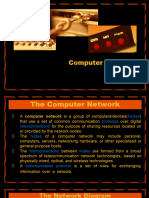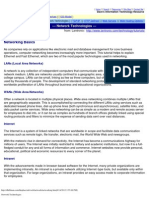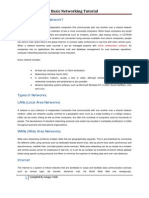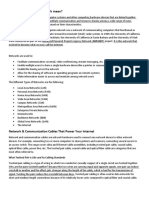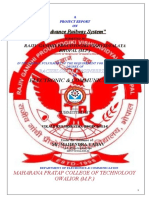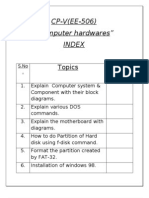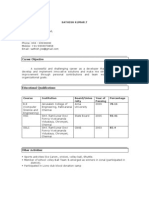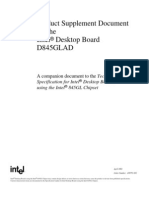Networking Methods: Local Area Network (LAN)
Networking Methods: Local Area Network (LAN)
Uploaded by
VIKALP KULSHRESTHACopyright:
Available Formats
Networking Methods: Local Area Network (LAN)
Networking Methods: Local Area Network (LAN)
Uploaded by
VIKALP KULSHRESTHAOriginal Title
Copyright
Available Formats
Share this document
Did you find this document useful?
Is this content inappropriate?
Copyright:
Available Formats
Networking Methods: Local Area Network (LAN)
Networking Methods: Local Area Network (LAN)
Uploaded by
VIKALP KULSHRESTHACopyright:
Available Formats
Vocational Training Course-2008
5
NETWORKING METHODS
Networking is a complex part of the computing and it covers the broader range of the
IT industry. All the communication in the world including satellite communication,
mobile communication, internet, telephones and WANs is due to the networking.
There are two main types of the networking.
Local Area Network (LAN)
A local area network is relatively covers small space and provides services to a small
amount of people. A local area can be divided into two major types, peer to peer and
the client server. Depending on the number of the users a network is configured.
Among the few examples of the peer-to-peer networks are small office network and
home networks. On the other hand, in the client/server-networking model all the
client computers depends on the server for resources like (modem, printer, scanner,
cd-rom) and they are connected with the server. The servers in the client/server
networking model works in different capacities like single service server and multiple
service servers.
Wide Area Network (WAN)
A wide area network is a network where are large number of the resources are
deployed in a very wide geographically area. The best example of the WAN is the
internet itself, which is a largest network in the world.
In order for communication to take place between the computers the mediums must
be used. These mediums can be cables, Routers, Repeaters, Ethernet, Protocols
and switches etc. These different mediums make the data communication possible in
different scenarios.
Types of WANs
There are two basic types of Wide Area Networking.
A computer network is set of computers and devices that are connected with each
other. Examples of the networks are the Internet, local area network, Wide area
network and satellite networks.
Centralized WANS:
A WAN that consists of a server or a group of servers in a central location to which
client computers connect, the server provides the most of the functionalities of a
network. Many banks, large stores, large schools and universities use centralized
AIR GWALIOR C.P.Harikumar-2008
Vocational Training Course-2008
WAN. A centralized wide area network may have a number of the servers in the
centralized location.
Distributed WAN:
A wide area network that consists of the client and server computers that are
distributed throughout the WAN, the functionalities of the network are distributed
throughout the WAN. The internet is an example of the wide area network.
The impact of Wide Area Networking on business
In this age of information, data communication (sending and receiving data) over a
long distance is a necessity. There have been number of technologies developed
that enable networks and their users to communicate with each other, and exchange
data easily even if they are at the different end of the world. Geographical area is no
more a matter in today’s communication age. Because of this the communication
through WAN has been become vital. Wide area networks make it feasible for the
companies to have a single network, which will connect their several offices and
departments. Companies, banks, large organizations often have their offices spread
over a large distance. Without wide area networking the people of a multinational
organization can face difficulties to communicate with each. WANs are important in
connecting institutes they are very far from each other.
The main purpose of the wan is to establish a secure, fast and reliable communicate
channel among the people who are widely away from each other. Wide area
networks are often privately owned networks. A wide area network uses many types
of network devices such as WAN switches, access servers, CSU/DSU, modems,
ISDN terminal adapters, routers, multiplexers, ATM switches and other networking
devices. An example of the WAN is SURF net, which is a research network and that
connects the universities and research centers of the Netherlands with each other.
What is Ethernet ?
In this section you will learn about the lan terminology, basic ethernet networking
overview, a general introduction to LAN, introduction to IEEE, lan topologies, wan
standards. You can also find these categories in this site such as network tutorials,
computer networking guide, what is networking, tech study guides, topologies, what
is data recovery, wireless communication, computer interview questions and network
certification. The IEEE standards have been developed by the International
Standards Organization (ISO). The Institute of Electrical and Electronic Engineers
(IEEE) in 1985 produced a series of standards for the Local Area Networks, which
are called IEEE 802 standards.
These standards have been accepted widely throughout the IT world. One of the
IEEE 802 standards, the IEEE 802.3 is known as “Ethernet”. Ethernet is the most
widely used LAN technology. Ethernet was developed by Xerox corporations in 1972
and it was the first LAN.
According to the ISO standards allows manufactures to produce the devices and
equipments, which are guaranteed to operate anywhere.
AIR GWALIOR C.P.Harikumar-2008
Vocational Training Course-2008
The Ethernet in its simplest form uses a passive bus that operates at 10 Mbps. The
bus is formed from the co-axial cable, which connects all the PCs in the LAN.
A single LAN may have 1024 attached computers, although in the real practice most
LANS have fewer computers than this number. One or more segments of the co-
axial cable are attached to end to end to create the Ethernet Cable Segment. Each
segment is terminated by 50-ohm resistors.
In today’s IT world the reliable and timely access to the information has become vital.
Today coworkers thousands of miles apart from each other can share data, voice,
video etc with the fractions of seconds. Similarly a larger number of the coworkers
can review the research data simultaneously. The Internet allows businesses to
share information and resources with their customers.
Ethernet is a communication protocol that is embedded in software and hardware
devices that intended. Ethernet has become the standard computer networking
protocol with the help of the Xerox, Intel and Digital
A basic LAN consists of the following components.
• Two or more computers.
• Network Interface card or LAN Card in each PC.
• Ethernet cable (Cat5, UTP/SPT) cable to connect the two computers.
• A hub, switch or router to route or direct the network traffic.
• Software for the communication/computer networking.
A network interface card (NIC) is attached and installed in each PC and is assigned
a unique address. An Ethernet cable is used to connect two computers; Ethernet
cable has RJ45connectors at both ends. There can be two scenarios 1. Two
computers can directly connect with each other or 2. Each computer is directly
connected with the hub/switch and hence communication occurs in the network. The
hub or switch acts as relay.
Computer Network can be wireless. Despite of using Ethernet cable for the
communication, Wireless Network Interface cards use radio waves to communicate
with the wireless switch or hub. A small antenna is used in the wireless NICs,
switches and hubs. Although the wireless networks are more easy to use as
compared to the cabled networks, but more configurations and extra care is required
to setup and run a wireless network.
The alternate technologies to Ethernet are “Token Ring”, which is used in the Ring
Topologies networks. Token Ring is designed by the IBM and ATM. In ATM
networking, devices are connected with each other over a very large distance (thus
forms the WAN), and behaves like LANs.
Ethernet is a well-established and widely used network standard for small to medium
sized Ethernet networks as well as for other networks. Ethernet has been used over
the 3 decades and forms a very excellent networking/communication environment.
Ethernet Terms
AIR GWALIOR C.P.Harikumar-2008
Vocational Training Course-2008
Ethernet follows a simple set of rules. To understand these rules its important to
understand thefollowing terminology.
• Node – The devices that are attached to the segments are nodes.
• Frame – The nodes (computers or network devices) communicates in the form of
short messages that are known as frames. The frames are chunks of information
with variable size.
• Segment – A single shared medium is known as a Ethernet segment.
• Medium – The Ethernet devices are attached to a common medium. The frames of
the data travel along with that medium. This medium can be coaxial cable. Today
most commonly used communication mediums are UTP/STP cable, fiber optic
cables.
Frames are analogous in human language. We have some rules for constructed the
sentences. The
Ethernet protocol specifies a set of rules for constructing the frames. The frames
length varies. Each frame must contain source and destination address for the
identification of the recipient and the send of the message. The nodes can be
uniquely and easily identified. Each Ethernet devices must have a single unique
address.
Compute networking standards has brought a revolution in the network computing
and it made the communication very easy and standardized. Now every computer
and networking devices has to to follow the same standard to communicate with
each other.
****
AIR GWALIOR C.P.Harikumar-2008
You might also like
- Technical Report On Computer NetworkingDocument15 pagesTechnical Report On Computer NetworkingTridib71% (7)
- LOCAL AREA NETWORKS Unit 2Document52 pagesLOCAL AREA NETWORKS Unit 2G.AkshayaNo ratings yet
- What Is EthernetDocument3 pagesWhat Is EthernetKumar GauravNo ratings yet
- AY2021 Networking Concepts Notes 1Document9 pagesAY2021 Networking Concepts Notes 1Priam Sujan KolurmathNo ratings yet
- What Is A Computer NetworkDocument21 pagesWhat Is A Computer NetworkPradeep PatilNo ratings yet
- Computer Networks BasicsDocument29 pagesComputer Networks BasicsAftab AliNo ratings yet
- What Is A Computer NetworkDocument22 pagesWhat Is A Computer NetworkAakash DashNo ratings yet
- Assignment Nam2Document20 pagesAssignment Nam2ĐứcNo ratings yet
- Unit 1Document121 pagesUnit 1ameer.amarteyNo ratings yet
- Description of Network TopologiesDocument12 pagesDescription of Network TopologiesDUSABIMANA CYRIAQUENo ratings yet
- Ecommerce - Lesson 3Document7 pagesEcommerce - Lesson 3Stephanie AndalNo ratings yet
- What Is A Computer Network?: Networking in GeneralDocument19 pagesWhat Is A Computer Network?: Networking in GeneralMahesh KarreiahgariNo ratings yet
- Theplace: Ethernet Tutorial Part 1: Networking BasicsDocument6 pagesTheplace: Ethernet Tutorial Part 1: Networking BasicsObaid GillNo ratings yet
- To Study About Various Parts, Cable and Connections in PC CommunicationDocument16 pagesTo Study About Various Parts, Cable and Connections in PC CommunicationPankaj GillNo ratings yet
- What Is A Computer NetworkDocument14 pagesWhat Is A Computer NetworkcaseyfarmerNo ratings yet
- Basic Networking Tutorial: What Is A Computer Network?Document21 pagesBasic Networking Tutorial: What Is A Computer Network?Nooruddin SheikNo ratings yet
- Ecse Unit IVDocument14 pagesEcse Unit IVSherlock337No ratings yet
- An Assigenment On:-: 1. Basic of Networking 2. Introduction To Network Types 3. Internet and IntranetDocument8 pagesAn Assigenment On:-: 1. Basic of Networking 2. Introduction To Network Types 3. Internet and IntranetaamirNo ratings yet
- Computer Network Tutorial by VipulDocument21 pagesComputer Network Tutorial by VipulVipul Sharma100% (1)
- Chapter-1: NetworkDocument52 pagesChapter-1: NetworkUGC NADNo ratings yet
- Soltech Computer Academy PC Know-How: (Networking)Document43 pagesSoltech Computer Academy PC Know-How: (Networking)owen-agboje-79850% (1)
- Module 1 - PPT - 1Document54 pagesModule 1 - PPT - 1Anubhab SarmaNo ratings yet
- Bagaimana LAN BerfungsiDocument5 pagesBagaimana LAN BerfungsiZarina Abdul RahimNo ratings yet
- Network ch5Document8 pagesNetwork ch5Tesfay GebretsadkanNo ratings yet
- Textbook Unit 15+ 16Document23 pagesTextbook Unit 15+ 16Hùng Nguyễn PhiNo ratings yet
- Types of Networks The Internet and Beyond Types of LAN TechnologyDocument12 pagesTypes of Networks The Internet and Beyond Types of LAN TechnologysiddhueceNo ratings yet
- Presentation On Peer-To-peer NetworksDocument13 pagesPresentation On Peer-To-peer NetworksDhara R. PatelNo ratings yet
- INTRODUCTIONDocument7 pagesINTRODUCTIONMazen NabeelNo ratings yet
- Ethernet TutorialDocument21 pagesEthernet TutorialKcirex GarinNo ratings yet
- Chapter 1Document25 pagesChapter 1jasminesherwinpreamNo ratings yet
- Computer Networking Module Prasad DDocument28 pagesComputer Networking Module Prasad DBethelhem YetwaleNo ratings yet
- Local Area Networking TutorialDocument31 pagesLocal Area Networking Tutorialkumarjit deyNo ratings yet
- Network Intrusion DetectionDocument16 pagesNetwork Intrusion DetectionsateeshNo ratings yet
- Computer Studies IiDocument51 pagesComputer Studies Iiakaah.randyNo ratings yet
- 8-Introduction To Computer Networks - Telecommunications, The Internet, and Wireless TechnologyDocument51 pages8-Introduction To Computer Networks - Telecommunications, The Internet, and Wireless TechnologysurangauorNo ratings yet
- Network 20210426203825Document51 pagesNetwork 20210426203825Rude AnimationNo ratings yet
- Network 20210426203825Document51 pagesNetwork 20210426203825M VAMSINo ratings yet
- Lec 3Document45 pagesLec 3ippili24181No ratings yet
- Introduction To Computer Networks Session 1Document50 pagesIntroduction To Computer Networks Session 1Msambili NdagaNo ratings yet
- Cosc 0160 Types of Computer NetworksDocument6 pagesCosc 0160 Types of Computer NetworksIANNo ratings yet
- IT ReportDocument40 pagesIT ReportAnanmay DixitNo ratings yet
- Lect BCA DCN 1 ADocument51 pagesLect BCA DCN 1 Adp0700897No ratings yet
- COP TOPIC2 - TOPIC 5 SummaryDocument48 pagesCOP TOPIC2 - TOPIC 5 Summarylombardmene7No ratings yet
- What Is A Computer Network?Document17 pagesWhat Is A Computer Network?Azhar MeraniNo ratings yet
- Chapter 5Document9 pagesChapter 5asmeabeba12No ratings yet
- 1 IntroductionDocument34 pages1 IntroductionSami AhmedNo ratings yet
- Basics of Computer Networks_Ater_School_GurukulDocument51 pagesBasics of Computer Networks_Ater_School_Gurukulbrilliant.learning01No ratings yet
- Computer Networks and Web TechnologiesDocument8 pagesComputer Networks and Web Technologiesmrsamaroo2018No ratings yet
- An Assigenment On:-: 1. Basic of Networking 2. Introduction To Network Types 3. Internet and IntranetDocument8 pagesAn Assigenment On:-: 1. Basic of Networking 2. Introduction To Network Types 3. Internet and Intranetvipin singhNo ratings yet
- Computer Network ConceptsDocument8 pagesComputer Network ConceptsMozart Luther MagbanuaNo ratings yet
- Grade 11 - Week 7 Infosheet The Basic of NetworkingDocument8 pagesGrade 11 - Week 7 Infosheet The Basic of NetworkingMELAIDA CASTANAR GARIBAYNo ratings yet
- Computer Network: PropertiesDocument4 pagesComputer Network: Propertiesanup_verma71No ratings yet
- NetworkspideDocument47 pagesNetworkspideZubair AliNo ratings yet
- Activity 1 1. What Is Computer Networks?Document9 pagesActivity 1 1. What Is Computer Networks?Katrina Mae VillalunaNo ratings yet
- NetworkingDocument90 pagesNetworkingankitkrydv0660No ratings yet
- Elements of Networks of Network EconomyDocument7 pagesElements of Networks of Network EconomyTechniworkNo ratings yet
- Setting Up Computer NetworksDocument7 pagesSetting Up Computer NetworksNinja ni Zack PrimoNo ratings yet
- CompTIA Network+ (N10-009) Study Guide: Comprehensive Exam Preparation and Key Concepts for Network ProfessionalsFrom EverandCompTIA Network+ (N10-009) Study Guide: Comprehensive Exam Preparation and Key Concepts for Network ProfessionalsNo ratings yet
- 11 AppendixDocument48 pages11 AppendixVIKALP KULSHRESTHANo ratings yet
- Phase Locked Loop DesignDocument13 pagesPhase Locked Loop DesignVIKALP KULSHRESTHANo ratings yet
- WaveguidesDocument41 pagesWaveguidesVIKALP KULSHRESTHA80% (5)
- MatlabDocument176 pagesMatlabhonnamb100% (1)
- Satellite CommunicationsDocument743 pagesSatellite CommunicationsVIKALP KULSHRESTHA100% (5)
- Asynchronous Transfer Mode (ATM)Document27 pagesAsynchronous Transfer Mode (ATM)VIKALP KULSHRESTHANo ratings yet
- Mejor ProjectDocument42 pagesMejor ProjectVIKALP KULSHRESTHANo ratings yet
- Data Structure File MPCTDocument37 pagesData Structure File MPCTVIKALP KULSHRESTHANo ratings yet
- Comm AnalogDocument29 pagesComm AnalogShaveen BeedasyNo ratings yet
- Fina Training ReportDocument36 pagesFina Training ReportVIKALP KULSHRESTHANo ratings yet
- Lanwan Network DevicesDocument3 pagesLanwan Network DevicesVIKALP KULSHRESTHANo ratings yet
- Hardware of ComputerDocument25 pagesHardware of ComputerVIKALP KULSHRESTHANo ratings yet
- Introduction To Isdn LineDocument3 pagesIntroduction To Isdn LineVIKALP KULSHRESTHANo ratings yet
- Hard Disk BasedDocument3 pagesHard Disk BasedVIKALP KULSHRESTHANo ratings yet
- Radar Fundamentals Power Point PresentationDocument51 pagesRadar Fundamentals Power Point PresentationVIKALP KULSHRESTHA100% (3)
- A Project Synopsis OnDocument11 pagesA Project Synopsis OnVIKALP KULSHRESTHA100% (2)
- Micro Strip BasicsDocument6 pagesMicro Strip BasicsshynusvNo ratings yet
- Practical File On Electronic-II: Submitted To Submitted byDocument16 pagesPractical File On Electronic-II: Submitted To Submitted byVIKALP KULSHRESTHANo ratings yet
- Power Point Presentation - Radar 04Document31 pagesPower Point Presentation - Radar 04VIKALP KULSHRESTHANo ratings yet
- BIOS Seminar PresentationDocument23 pagesBIOS Seminar PresentationVIKALP KULSHRESTHA67% (3)
- Career Objective: Sathish Kumar.TDocument3 pagesCareer Objective: Sathish Kumar.TBala GangadharNo ratings yet
- Introduction and Web Development Strategies / Web TeamDocument3 pagesIntroduction and Web Development Strategies / Web TeamlalithaNo ratings yet
- 02 eLMS Activity 2 - Zach StarDocument4 pages02 eLMS Activity 2 - Zach StarJames OrenaNo ratings yet
- Walkthrough - Printing A Local Report Without PreviewDocument6 pagesWalkthrough - Printing A Local Report Without PreviewJerry AndersonNo ratings yet
- Dingo Ex2002Document70 pagesDingo Ex2002Fabian CuevasNo ratings yet
- Tablespaces AdminDocument2 pagesTablespaces AdminMaloumba papi2No ratings yet
- Current LogDocument10 pagesCurrent LogMulyati AtiNo ratings yet
- A Project Report On Smart Bell With Electronic Timetable DisplayDocument83 pagesA Project Report On Smart Bell With Electronic Timetable Displaytamma mounika58No ratings yet
- 25AA640A/25LC640A: 64K SPI Bus Serial EEPROMDocument36 pages25AA640A/25LC640A: 64K SPI Bus Serial EEPROMmarino246No ratings yet
- ReportDocument55 pagesReportrfzNo ratings yet
- 3.5 Buffer Overflow, Integer and Heap OverflowDocument60 pages3.5 Buffer Overflow, Integer and Heap Overflowdangkhacthanh15042002No ratings yet
- Microprocessor SlideDocument60 pagesMicroprocessor Slideabm wahiduj jamanNo ratings yet
- Instal 0Document5 pagesInstal 0api-3756103No ratings yet
- Installation Guide S900Document28 pagesInstallation Guide S900veerabossNo ratings yet
- Re-Install Galaxy Pocket GT-S5300 With Stock XXLF5 FirmwareDocument2 pagesRe-Install Galaxy Pocket GT-S5300 With Stock XXLF5 Firmwareovan98No ratings yet
- Dacia Maps Application Guide enDocument7 pagesDacia Maps Application Guide enHitoNo ratings yet
- How To Keep Your Windows 10 Device Secure When You Are Away From ItDocument6 pagesHow To Keep Your Windows 10 Device Secure When You Are Away From ItRick NorthorpNo ratings yet
- Developing Ssrs Reports For Dynamics AxDocument23 pagesDeveloping Ssrs Reports For Dynamics AxAhmed Farag IbrahimNo ratings yet
- Product Supplement Document For The Intel Desktop Board D845GLADDocument34 pagesProduct Supplement Document For The Intel Desktop Board D845GLADJoão FernandesNo ratings yet
- Research On The Security Problem in Windows 7 Operating SystemDocument4 pagesResearch On The Security Problem in Windows 7 Operating SystemLeinoj LopezNo ratings yet
- Unit 1 Computer Applications: Picture 1.1Document10 pagesUnit 1 Computer Applications: Picture 1.1Faris IkhlasulNo ratings yet
- Unlimited Bitcoin JackpotDocument145 pagesUnlimited Bitcoin JackpotMUHAMMED SHAHASNo ratings yet
- VMware SD-WAN by VeloCloud Edge Data SheetDocument8 pagesVMware SD-WAN by VeloCloud Edge Data SheetHua Ern ZowNo ratings yet
- TD's Flexible Volume Profile (MT4) : Installation & AuthorizationDocument7 pagesTD's Flexible Volume Profile (MT4) : Installation & AuthorizationRui LopesNo ratings yet
- Airport Management System FinalDocument48 pagesAirport Management System FinalVarun Kalpurath100% (6)
- Hello PythonDocument19 pagesHello Pythonasim palNo ratings yet
- 1.2 Processes: 1.2.1 Process Model, Creation, Termination, States & TransitionsDocument3 pages1.2 Processes: 1.2.1 Process Model, Creation, Termination, States & TransitionsPraveenYadavNo ratings yet
- C-Data Epon Olt Fd1108s Cli User Manual v1.3Document89 pagesC-Data Epon Olt Fd1108s Cli User Manual v1.3sarasa100% (2)
- Lecture 3-Script and FunctionDocument28 pagesLecture 3-Script and FunctionViet PhamNo ratings yet
- Functional Analysis Standard Report TXDocument12 pagesFunctional Analysis Standard Report TXPriyankaBajpai23No ratings yet








